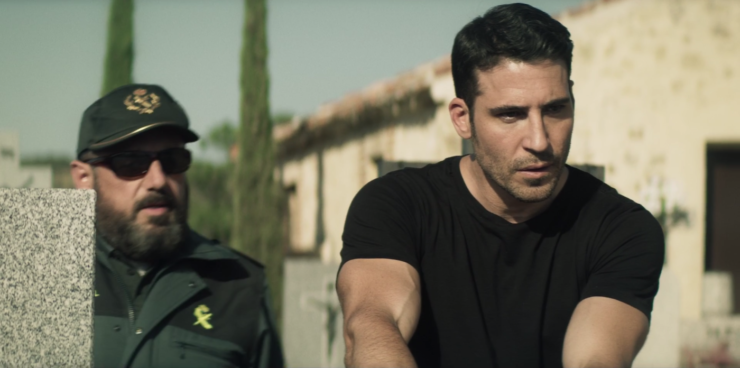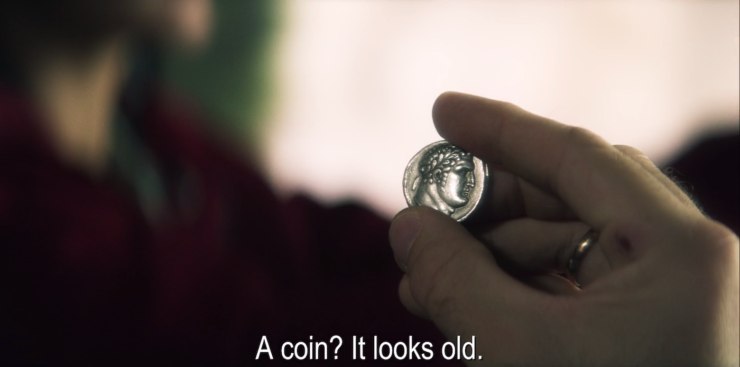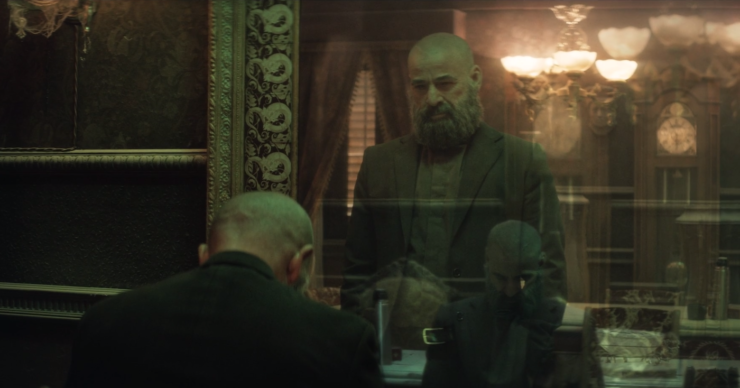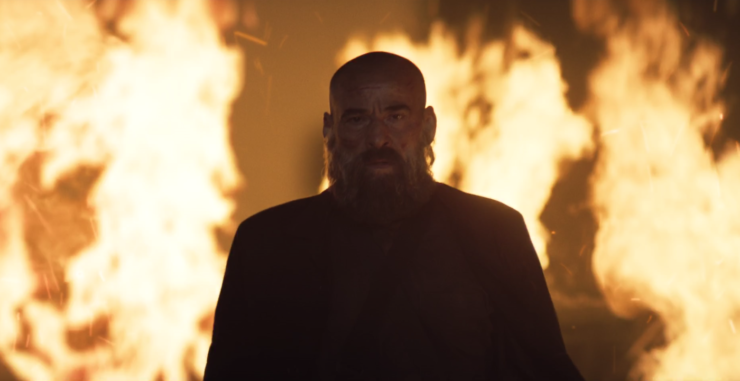If you like horror, Silent Hill, religious conspiracies, or love triangles, you should probably watch 30 Coins. If you enjoy yelling “WHAT???” and “ARE YOU KIDDING ME???” and “WHAT THE HELL IS THAT THING???” at your TV, you should definitely watch 30 Coins. And if you think that what Catholicism really needs is more human/spider hybrid monsters, I have fabulous news for you. Also a lot of questions.
The show’s 8-episode arc just wrapped up on HBOMax, after running on HBO Europe earlier in the winter. The overall arc is an excellent work of religious horror, but where the show truly shines is in committing to different types of horror in each episode, and it gives us everything from spooky ouija sessions to mirrors that might actually be inter-dimensional portals, to possessed revenants, but somehow director/writer Álex de la Iglesia and co-writer Jorge Guerricaechevarría make all of these elements tie into the overall conspiracy plot.
And now that we’re safely below the cut I can say, with love, that each episode of 30 Coins is utterly BATSHIT.
About that plot: when Judas betrayed Jesus, he was paid with 30 pieces of silver. 30 Coins proposes that those coins are imbued with Ark of the Covenant-style power, and, as in the Indiana Jones films, those powers can be wielded by evil people if they gather enough of them. It just so happens that there’s a secret evil-worshipping cabal within the Catholic Church! And guess who has a nefarious ancient mission?
When a priest with a mysterious past comes to the small town of Pedraza, Spain, he unknowingly brings one of the coins with him, and soon he and the town are caught up in dark machinations. And it’s GREAT, because the conspiracy involves things like cows giving birth to human babies, giant, Silent Hill-esque human/spider hybrids, cursed mirrors, revenants, psychic teens, eeee-villl doppelgangers, and dozens of other beautiful horror tropes, all converging on this one poor town. It’s also legitimately scary. When the show focuses on a monster, it’s a good, frightening monster. When it wants to create a more subtle, uncanny tone, it can do that as well. But it also knows how to dole out facts about the sinister conspiracy often enough to build suspense across the whole series.

One of the reasons the show works so well is that Pedraza’s residents are regular people, most of whom don’t understand they’re in a horror series until around episode seven. The explosion of religious horror and giant spider-human hybrids and revenants takes place over about 6 months, in what was, until then, a quaint little Spanish town. The only ones who realize something is wrong in episode one are the police chief, Laguna, the town’s ridiculously attractive mayor, Paco, and the town’s even-ridiculously-hotter veterinarian, Elena Echevarría. Paco, who only became mayor at his wife Merche’s suggestion, now spends most of his time running between uncanny disasters, usually clad in skintight polo shirts, cursing the day he was elected.
The rest of the residents take a little longer to catch up. Merche spends the entire series desperately trying to leverage Paco’s popularity as mayor for their two businesses: an abattoir, and a boutique hotel. It’s as if a Parks and Rec characters was trying to run a charming bed-and-breakfast on one of the side streets in Silent Hill. And since her boosterism and hyper-competence simply won’t acknowledge that her town has become portal to Hell, you end up with moments where one character is being hunted down by an unkillable Satanic assassin, and another has just attended the funeral of a man who killed himself after the man he murdered years before suddenly showed up as a walking corpse, and these plotlines crash right into poor Merche as she’s trying to tell a pair of Japanese tourists when the town’s castle will be open for a tour. When Father Vergara’s not celebrating Mass, he’s suffering from Guilt Flashbacks or sparring with a punching bag for reasons involving his Mysterious Past. Elena broods over her missing husband while fending off accusations of witchcraft from her neighbors and accusations that she’s seducing Paco from Merche, and, occasionally, working with animals briefly… until GIANT FUCKING MONSTERS SHOW UP TO EAT HER.

This happens a lot, and she never gets used to it. But none of this quite gets at the show’s strength, which is its utter willingness to slalom between different types of horror, romantic tension, theology arguments, flashbacks to prison boxing tournaments, teen drama—I try not to cheapen the beauty of Stefon by invoking him too often, but this show truly has everything.
And then in episode 3, “The Mirror”, it vaults its way into my heart with a long conversation about Judas and the nature of evil.
Look, I’m a person of simple pleasures. I don’t have many needs. But one of those needs is plot heavy shows that stop dead for theological discussion. It’s why Daredevil is the best Marvel show, why The Exorcist is the best horror movie, why First Reformed is the best Calvinist drama. 30 Coins spends ten glorious minutes of its runtime allowing Vergara to walk Paco through some Nikos Kazantzakis 101, which is what I’m gonna do now.
You’re welcome.

You know how it’s in vogue at the moment to give every villain an origin story? Future alien archaeologists are going to ask each other why we were so obsessed with this person called the Joker, and why we invented tortured backstories for Cruella de Vil and Gaston and a bunch of other people whose origins we probably shouldn’t probe too deeply. There’s an argument to be made that this started with Judas. In all four of the Gospels, Judas sells Jesus out pretty abruptly. In Mark no reason is given, in Matthew he’s in it for the thirty pieces of silver, and in Luke and John he’s possessed. But almost immediately theologians began arguing about why and how the betrayal happened—some to try to make the four canonical gospel accounts align (always a fun project) and some to see if there was some deeper, hidden meaning. By the 13th Century people were already trying to see if perhaps it was society that turned him bad? Wait, just kidding, it was a woman! In a 13th C ballad titled, simply “Judas” (imagine Joker font if you want) Judas is convinced to betray Jesus by his evil sister. I couldn’t find evidence of a backstory for her.
In the early 1300s, Dante Alighieri went for a gritty reboot that landed Judas in the Ninth Circle of Hell, being continuously devoured by one of the three heads of Satan along with Brutus and Cassius. By the 1800s people were complicating the story again, with novels writing a Judas who wanted to lead a political revolution, or trying to force Jesus’ hand and get him to declare himself king. These themes crop back up in Bulgakov’s Master and Margarita, Borges’ work, and in Kazantzakis’ The Last Temptation of Christ. Tim Rice and Andrew Lloyd Weber made Judas the lead for Jesus Christ Superstar, a freedom fighter who wants Jesus to stick to his earlier script of freeing the Hebrews from the tyranny of Rome, and his betrayal is framed as an attempt to force Jesus’ hand and spark a revolution. Last Temptation was then adapted into a movie by noted gatekeeper Martin Scorsese, who emphasized the idea that Jesus made Judas betray him. (Since the internet is terrible: that last line is a joke. Martin Scorsese is our greatest living filmmaker, and he’s right almost all the time!) More recently, Judas has also been recast as Dracula in Dracula 2000, and he might be the DC character The Phantom Stranger.
Now, this isn’t everything, but I thought it was worth noting the ways this character/person/ideological concept has been complicated over the centuries. 30 Coins runs with the same theory that Kazantzakis and Scorsese explore: Judas was playing a difficult and painful role in a Divine Plan. Judas going through with the betrayal was a pivotal moment in history. Like Superstar’ Judas, this one is a passionate anti-Roman rabblerouser, and the mushy God stuff makes him nervous, and he’s traumatized to find out that his hoped-for revolution is actually going to be much more cosmic, and that he has to be the villain in the story. This idea has been taken up by a group called The Cainites, who regard Judas as the greatest of the saints, because he traded his soul to lay the groundwork for the Resurrection. But now the modern version of that group is taking over the Vatican, hunting down the coins, and making Father Vergara’s life really, really difficult.

While watching 30 Coins, I found myself thinking a lot about CBS’ supernatural procedural, Evil. Evil is successful because it carefully threads between supernatural and reason. David Acosta, a priest-in-training, believes that all the strange events happen as part of an eons-old battle between good and evil. His two coworkers, however, a lapsed Catholic and a lapsed Muslim, respectively, find logical explanations for most of the almost everything. The showrunners never allow Evil to turn into Touched by an Angel, explaining all the supernatural events by citing some pat Divine Plan, but they’re also careful not to tip so far into logical explanations as to sap the mystery from the show. Some of the uncanny things are allowed to stay uncanny.
In 30 Coins, however, the audience knows immediately that the supernatural stuff is supernatural. The show never questions its religious underpinnings—the only question is whether the people who seem to be good will be able to hold out against the forces of evil. The show is overstuffed in the best way. It packs an absurd number of plot twists and creepy imagery into its hour-long episodes, but it also grounds the action in human emotion. Elena’s grief for her missing husband becomes integral to the plot. For all the over-the-top humor, Paco and Merche’s marriage is treated as a complicated, living relationship. Father Vergara’s all-too-human struggle between wanting to have faith versus giving in to his fear of the Cainites, becomes the engine that drives the whole show. Also, I wasn’t expecting a religious horror soap opera? By the end of the season I was shocked at how much I cared about the townspeople, how invested I was in the love triangle between Paco, Merche, and Elena. Eduard Fernández, Miguel Ángel Silvestre, and Megan Montaner are all fantastic as Vergara, Paco, and Elena respectively, but I think my favorite might be Macarena Gómez, who nimbly careens through comic relief and pathos as Merche, often within a single scene.
And after seven incredible episodes, they stick the landing in the finale, and set up a jaw-dropping cliffhanger for a possible second season. 30 Coins is miraculous.










